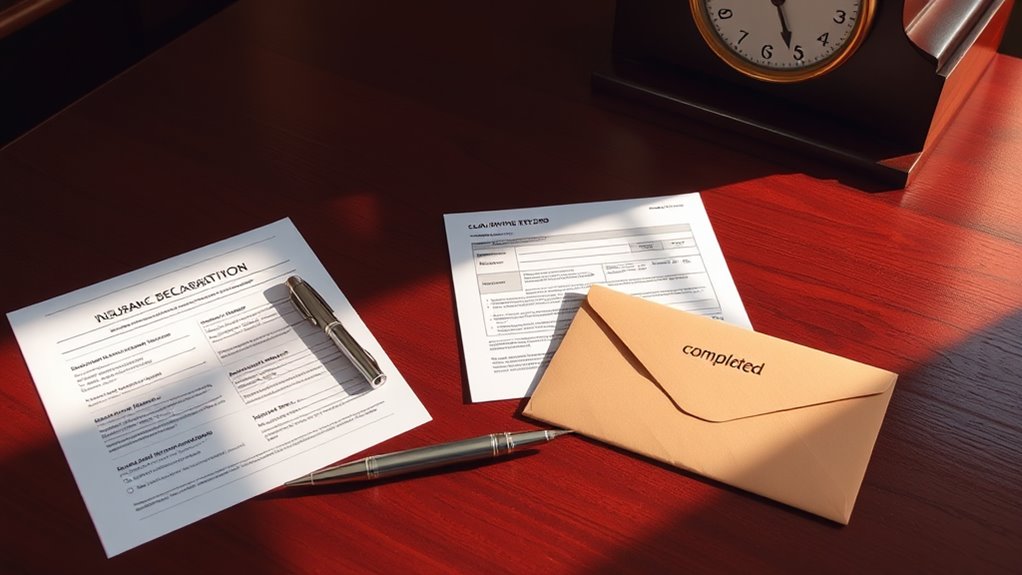Need SR-22 insurance assistance?
 CALL our licensed Agents
(Mon-Fri, 8am – 5pm PST) for personalized guidance CALL our licensed Agents
(Mon-Fri, 8am – 5pm PST) for personalized guidance
|
To get your SR-22 removed, you'll need to check your state-specific filing period (typically 1-3 years) and verify all requirements with your local DMV. Maintain a spotless driving record, pay any outstanding fines, and complete all court-ordered programs like defensive driving or substance abuse rehabilitation. Keep continuous insurance coverage without any lapses, and gather necessary documentation including court papers and completion certificates. When your filing period ends, contact your insurance provider to submit removal request forms to the DMV. Once approved, you can shift to standard auto insurance – but there's much more to evaluate for a successful removal process.
Check Your SR-22 Filing Period
The first essential step in removing your SR-22 is to verify your state's mandatory filing period. Most states require SR-22 filings for 1 to 3 years, though some states like Tennessee may extend this to 5 years. Your filing period starts from the date of your original offense.
You'll need to know your state's specific requirements. For example, Alabama, Arizona, and Colorado mandate 3-year periods, while Arkansas typically requires 2 years. States like New Hampshire and Pennsylvania do not require SR-22 filings at all. Additionally, it's important to keep in mind that SR22 insurance is specifically designed to enhance accountability for drivers with a history of risky behavior. Maintaining non-owner SR22 insurance coverage can also help you fulfill your SR-22 obligations without owning a vehicle.
During this time, you must maintain continuous insurance coverage without any lapses. If your insurance lapses or gets canceled, your DMV will be notified, and your license could be suspended immediately.
Be aware that any new violations during your SR-22 period may reset your timeline or prevent early removal.
Review State Requirements
Once you've confirmed your filing period, understanding your state's specific SR-22 requirements becomes your next priority.
You'll need to research your state's unique rules, as requirements vary greatly across jurisdictions. Some states allow early removal, while others strictly enforce the full duration. Additionally, it's beneficial to compare multiple SR22 insurance quotes to find the most affordable coverage options before making any changes.
Before proceeding with removal, you must fulfill all court-ordered obligations, including DUI education classes, treatment programs, and outstanding fines.
Failure to complete these requirements can extend your SR-22 period.
Contact your local DMV to verify exact end dates and obtain necessary documentation. You may receive an official letter confirming the end of your filing period, which your insurance company might require.
In Texas, an SR-22 is typically required after a DWI conviction and following specific legal protocols, including completing the required waiting periods.
Following your state's specific protocols guarantees a smooth change back to standard insurance coverage.
Maintain Clean Driving Record
Maintaining a spotless driving record is essential while your SR-22 is in effect, as any violations could reset your filing period or trigger additional penalties.
You'll need to strictly follow all traffic laws, including speed limits and signals, while consistently practicing defensive driving techniques. Keep a safe distance from other vehicles, avoid distractions, and always wear your seatbelt.
It's vital to stay completely sober when driving and avoid high-risk situations like late-night travel or adverse weather conditions.
Consider enrolling in defensive driving courses to improve your skills and demonstrate your commitment to responsible driving. These courses can help you learn valuable techniques for hazard prevention and may support your case for early SR-22 removal in some states.
Plan alternative transportation when necessary to avoid compromising your clean record.
Pay Outstanding Fines
Beyond maintaining a clean driving record, addressing outstanding fines represents a key step toward SR-22 removal.
You'll need to settle all fines related to your original offense and any subsequent violations before you can proceed with removing your SR-22 filing.
- Check with your local DMV and court system to identify all outstanding fines
- Pay the full amount owed through approved payment methods
- Obtain and retain proof of payment for your records
- Verify that payments have been properly recorded in the system
Don't delay in addressing these financial obligations, as unpaid fines can prevent your SR-22 removal and potentially reset your filing period.
Contact your court or DMV directly to confirm the exact amount owed and acceptable payment methods.
Remember to keep documentation of all transactions for future reference.
Complete Court-Ordered Programs
If you've been ordered to complete specific programs by the court, meeting these requirements is crucial for your SR-22 removal process. Common programs include substance abuse rehabilitation, defensive driving courses, and traffic safety classes, depending on your offense.
To fulfill these requirements, you'll need to enroll in state-approved programs, attend all mandatory sessions, and obtain certificates of completion.
Submit these documents promptly to your court or DMV as proof of compliance. Keep detailed records of your participation and completion dates.
Failing to complete court-ordered programs can severely impact your SR-22 status. You risk license suspension, additional penalties, and extension of your SR-22 requirement period.
Stay proactive in meeting all program deadlines and requirements to guarantee a smooth path toward SR-22 removal.
Document Insurance Coverage History
Proper documentation of your insurance coverage history plays a significant role in getting your SR-22 requirement removed.
You'll need to maintain detailed records of your continuous coverage and guarantee all requirements are met throughout the filing period.
- Keep copies of all insurance policies, payments, and SR-22 filings with the DMV
- Set up auto-pay or payment reminders to prevent any coverage lapses
- Request written confirmation from your insurance provider about your SR-22 status
- Document all communication with your insurance company and the DMV
Stay proactive in maintaining your coverage and addressing any potential issues immediately.
If your policy is canceled or lapses, notify the DMV right away, as this could affect your driving privileges.
Remember to verify that your insurance meets your state's minimum liability requirements and that all necessary vehicles are covered under the SR-22.
Contact Your Insurance Provider
Taking a proactive approach with your insurance provider is essential when you're ready to remove your SR-22 filing.
Contact your insurer to notify them that your filing period has ended and request cancellation of the SR-22. Be prepared to provide any necessary documentation from the DMV to support your request.
Make sure your insurance company understands they'll need to submit an SR-26 cancellation form to the DMV.
Don't cancel your SR-22 prematurely, as this can result in license suspension, fines, and an extended filing requirement.
Verify the timeline for the cancellation process and confirm that your provider will handle all necessary paperwork with the DMV.
Once you've confirmed these details, you can begin exploring standard insurance options that may offer more competitive rates.
Submit Removal Request Forms
Once you've coordinated with your insurance provider, the next step involves submitting the necessary removal request forms to officially end your SR-22 requirement.
You'll need to work with your insurance company to file the SR-26 form, which verifies your SR-22 is no longer on file. Be mindful of your state's specific requirements, as additional documentation may be needed.
Key forms and documents you'll need to gather:
- SR-26 form from your insurance provider
- State-specific DMV certification forms
- Court documents confirming your SR-22 end date
- Any supplemental forms required by your insurance company
Ensure all paperwork is complete and accurate before submission.
Your insurance carrier will typically handle the filing process with the DMV, but you should follow up to confirm proper processing and removal of the SR-22 from your record.
Verify DMV Approval
Verifying DMV approval stands as an essential step in removing your SR-22 filing. You'll need to confirm that you've met all state-specific requirements and completed the mandatory filing period, which typically spans three years.
Contact your state's DMV directly or visit their website to verify your eligibility for SR-22 removal. You must guarantee you've maintained continuous insurance coverage and haven't incurred any new violations during the filing period.
Be aware that premature removal attempts can trigger serious consequences, including license suspension and filing period reset.
Once you receive confirmation, request written documentation from both the DMV and your insurance provider. This paperwork serves as proof that your SR-22 obligation has been officially terminated and should be retained for your records.
Secure Standard Auto Insurance
After confirming your SR-22 removal with the DMV, securing standard auto insurance becomes your next priority.
You'll need to demonstrate that you're now a lower-risk driver to qualify for standard coverage. Research multiple insurance providers who specialize in moving drivers from non-standard to standard policies.
To improve your chances of approval, make sure you have:
- Maintained continuous insurance coverage without any lapses
- Built a clean driving record free of violations and accidents
- Established good credit through consistent financial management
- Updated your vehicle's safety features to meet current standards
Work with an experienced insurance agent who can guide you through the shift process.
They'll help you gather necessary documentation and compare quotes from various insurers to find the most competitive rates and thorough coverage for your specific situation.
Conclusion
Getting your SR-22 removed is like landing a plane – it requires careful attention to each step and patience during the descent. You'll need to maintain a spotless driving record, just as 87% of drivers who successfully remove their SR-22 do. By following these guidelines and staying committed to responsible driving, you're setting yourself up for a smooth shift back to standard insurance coverage and financial freedom.





